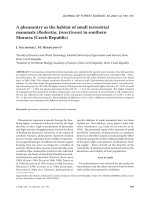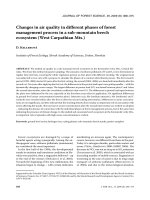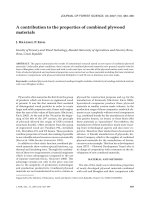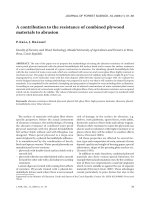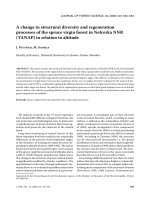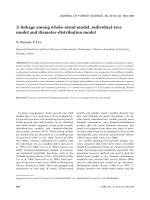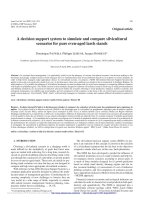Báo cáo lâm nghiệp: "A digital photographic method for 3D reconstruction of standing tree shape" ppt
Bạn đang xem bản rút gọn của tài liệu. Xem và tải ngay bản đầy đủ của tài liệu tại đây (1.67 MB, 7 trang )
Ann. For. Sci. 64 (2007) 631–637 Available online at:
c
INRA, EDP Sciences, 2007 www.afs-journal.org
DOI: 10.1051/forest:2007041
Original article
A digital photographic method for 3D reconstruction
of standing tree shape
Adrian Ilie Hapca
a
*
, Frédéric M
othe
b
, Jean-Michel Leban
b
a
Centre for Timber Engineering, Napier University, Merchiston Campus, Edinburgh, EH10 5DT, Scotland
b
INRA - Centre de Recherches de Nancy, Laboratoire d’Étude des Ressources Forêt-Bois, 54280 Champenoux, France
(Received 15 June 2006; accepted 15 February 2007)
Abstract – A digital photographic method is presented which is able to reconstruct the profile of the stem on standing trees up to a height of 12 m and
to provide a fine level of detail. The method uses two digital photographs taken at 90
◦
to each other and does not require special illumination conditions.
A method is proposed to perform the data acquisition process from the two photographs and to transform the stem dimensions and 3-D position from
pixels to units of length. The accuracy of this method for measuring tree shape was tested by comparing the results with those obtained from a laser
system. The comparison showed that the photographic method provides a good assessment of standing tree shape.
3D profile / standing trees / digital camera / photogrammetry / Picea abies
Résumé – Mesure de la forme des arbres sur pied par photogrammétrie. La méthode photographique présentée dans cet article permet la recons-
truction en 3D du profil du tronc d’arbres sur pied jusqu’à une hauteur de 12 m. On utilise un appareil photo numérique pour faire deux prises de vue
orientées à 90
◦
l’une de l’autre. Il n’y a pas de contrainte particulière d’éclairage. Le traitement des images conduit à la représentation tridimension-
nelle des tiges et à la mesure des indicateurs de forme. La précision de la méthode proposée est évaluée par référence à des mesures réalisées avec un
théodolite à visée laser. Les résultats montrent que la méthode photographique permet des mesures précises de la forme des arbres.
profil 3D / arbre sur pied / photo numérique / photogrammétrie / Picea abies
1. INTRODUCTION
The commercial value of logs for processing into solid
wood is mainly determined by the size and straightness of the
tree stem, and the number and size of branches. One of the
first steps required when converting trees to sawmill products
is a description of the quality of the raw material. According
to Lundgren [9], the geometry of a stem is a good indicator of
log quality. As a result, a variety of different non-contact ap-
proaches have been developed during the last century to col-
lect data on the stem characteristics of standing trees (e.g., tree
heights, upper stem diameters, stem straightness, form of stem
sections, crown projection, etc.). These approaches can be di-
vided into two broad categories (i) approaches for measur-
ing the tree dendrometric characteristics and (ii) approaches
for measuring the tree straightness. In both situations photo-
graphic techniques were generally employed, since they are
convenient for indirectly estimating the shape of the trees.
One of the pioneers in forestry photogrammetry was Weber
[15]. In 1902, he used a camera orientated parallel to the stem
axis to obtain tree dendrometric characteristics using a con-
version scale into the plane of the photograph. This principle
was used and improved later by Prodan [11], Crosby et al. [4],
Nosenzo [10] and Gaffrey et al. [6]. Recent developments in
* Corresponding author:
this area are characterised by the application of digital photog-
raphy [1, 2, 5, 8], whereby photographs are recorded directly
in digital format.
The approach of using photogrammetry to analyse the
straightness of standing trees was first proposed in the 1960s
by Shelbourne and Namkoong [13]. The principle was to
take photographs of a tree from two perpendicular directions.
These images represent the projection of the tree profile onto
the plane of the photographs. The straightness of the stem is
then expressed by the angle of lean and sums of squared devi-
ation to different axes. Two series of tests, one on a wire helix
and the other on eight 11-year-old plantation trees, were car-
ried out to estimate the angle of lean. Results showed that the
method is characterised by a high level of repeatability. How-
ever, with this method data are recorded from the photographs
using projections onto a screen which is time consuming and
can result in errors.
The methodology proposed by Shelbourne and Namkoong
[13] was improved by Thomas [14] who proposed using a 35-
mm camera and two flashes to provide better contrast in the
photographs. The author notes that the 35-mm camera used
gives the smallest distortion of the objects on the picture. The
photographic film is scanned and the assessment of the three-
dimensional (3D) shape of standing tress is done using a semi-
automatic imaging analysis procedure. To test the method,
three sets of photographs were taken. The results obtained
Article published by EDP Sciences and available at or />632 A.I. Hapca et al.
showed that the standard error for the diameter measurement
wasupto30mm.
Other methods have been used to measure the shape of
standing trees. Radi and Castera [12] estimated the 3D position
of the average profile of the stem by direct contact measure-
ments at different heights using a plumb line, while Constant
et al. [3] proposed a method which used laser systems (theodo-
lite method). In this method, a series of targets is attached to
a standing tree and the coordinates of these targets are mea-
sured using a theodolite. The tree is then felled, cut into logs
and the external shape of each log measured in the laboratory.
This information is then combined and used to reconstruct the
initial 3D shape of the tree. The accuracy of this approach was
quantified by taking two measurements of the coordinates of a
series of targets attached to nine mature standing trees, with-
out moving the total station. The results from the comparison
indicated a good level of precision for the first 12 m of the
stem (interval of uncertainty ± 7.2 mm) and lower for heights
above 12 m (interval of uncertainty ± 20.8 mm). According
to these authors, wind was the most limiting factor to measure
the position of the standing trees. The disadvantages of this
method are that a minimum of three targets per log must be
attached to the stem of standing trees, and considerable time
is required for the laboratory measurements (up to 4 h for one
2-m-long log) in addition to the field work. Furthermore, it is
a destructive method and therefore is not suitable for forest
inventories.
While the theodolite method has been shown to have a high
degree of precision and repeatability, it is unlikely to be used
in an operational context as studies on large numbers of trees
require faster and less expensive methods. With the develop-
ment of charged coupled devices (CCD), digital camera tech-
nology has become a relatively simple and efficient approach
to take photographs of standing trees. The primary advantage
of this technique is related to the fact that digital photograph
manipulation allows more operations to be carried out than
could be accomplished with standard film technology, such as
the analysis of histograms of colours. The aim of this paper is
twofold, firstly to show how the features in digital photographs
can be used to measure the 3D profile of a standing tree, and
secondly to test the repeatability of this method. Validation
of this method was achieved by comparing the standing tree
profile obtained by the photographic method with the profile
measured by the theodolite. The measurements were repeated
twice on two sets of photographs by two different operators.
Additional validation of the approach involved comparing es-
timates of stem slope in the first 4 m and stem diameters ob-
tained by the photographic method with those obtained from
direct measurements.
2. MATERIAL AND METHODS
2.1. Principle of the photographic method
The projection of a vertical flat object onto a parallel plane is given
by a homothety (i.e., a similarity transformation) with a scale factor
μ given by:
μ = f / D(1)
where for a camera, f is the focal distance and D is the horizontal
distance from the focus to the object.
In the case when the focal distance is not known, the scale factor μ
may be estimated by measuring the projected length l of a calibration
sample of length L placed in the object’s plane:
μ = l/L(2)
where, l is the length of the projection, and L is the real length.
In reality, a tree is not a flat object and the scale factor may vary
with the distance to the focus for each point on a tree. Nevertheless,
the error can be reduced by placing the camera far enough from the
tree (D is approximately 18.5 m in this study). Furthermore, the image
deformations due to the camera optics and the digitalization device
are much more complex than a simple homothetic transform.
Assuming that these transformations do not include any rotation or
shearing, we only have to consider the local variations of the scaling
factors in the horizontal and vertical directions. The ratio between the
scaling factors measured at two different points in the same image
does not depend on the target object, nor on the distance from the
object to the camera. It results from the previous hypothesis that the
field of variation of the relative scaling factors may be considered as
an acquisition system property, independent of the actual image.
To express the distortion we consider two relative scaling factors
FH (horizontal) and FV (vertical), defined at a given point within the
image as:
FH = μH/μ0H (3a)
FV = μV/μ0V (3b)
where, μH and μV are the horizontal and vertical scaling factors, re-
spectively, and μ0H and μ0V are the scaling factors at the centre of
the image.
We used a digital photograph of scaled paper to develop a regres-
sion model which allowed us to estimate the relative scaling factors
at any location in the vertical direction of any photograph taken using
the same camera settings. The horizontal distortion (FH) was esti-
mated using a second regression model involving the vertical relative
scaling factor (FV). This method makes use of a vertical calibration
sample placed in the same plane as the target tree for calibration.
By following the procedure described above, the scaling factors in
the horizontal and vertical directions for the digital photograph were
calculated for each point and expressed in millimetres/pixel. The di-
mension and the position on the picture of the tree projection can then
be transformed from pixels into millimetres.
Since one photograph of the tree represents its projection in a ver-
tical plane, the 3D profile of the tree can be obtained from two pho-
tographic images taken from two perpendicular directions (Fig. 1). In
this case, each photograph can be considered as representing the ZX
and ZY planes in a cartesian coordinate system, where the Z-direction
corresponds to the height of the tree, and the X-and Y-directions cor-
respond to the transverse section of the tree.
The diameters of the stem and the coordinates of the cross section
centre at height Z (Fig. 2) were calculated according to the formulae:
Dx =
Xr − Xl (4a)
Dy = Yr − Yl (4b)
X = (Xl + Xr)/2(4c)
Y = (Yl + Yr)/2 (4d)
where, Dx, Dy are the stem diameters in ZX and ZY planes, respec-
tively, X and Y are the coordinates of the cross-section centre, Xl, Xr
Measurement of standing tree shape by photographic method 633
Figure 1. Overview of methodology to measure the profile of a tree
using two photographs, taken from two perpendicular directions.
Figure 2. Schematic representation of the measurements taken in or-
der to record the profile of the stem in the XZ plane, and estimation
of the cross section coordinates at the height Z.
are the coordinates of the left and right hand edges of the stem cross-
section measured on photo 1, and Yl, Yr are the coordinates of left
and right hand edges measured on photo 2.
Using the 3D profile, the stem was characterised by two param-
eters: local slope (ε), related to the axis Z, and local slope orienta-
tion (β), related to the XY plane (Fig. 3). Both parameters were mea-
sured for the section of stem linking two cross-sections at heights 1
and 2. The local slope of the tree (ε) was defined as the angle be-
tween the vertical axis and the axis linking the centre of the cross-
sections, while the local slope orientation (β) is the azimuth of the
leaning direction. These parameters were calculated using the fol-
lowing equations:
ε = arctan
⎛
⎜
⎜
⎜
⎜
⎜
⎝
(
X2 − X1
)
2
+
(
Y2 − Y1
)
2
Z2 − Z1
⎞
⎟
⎟
⎟
⎟
⎟
⎠
(5a)
β = arctan
X2 − X1
Y2 − Y1
(5b)
Figure 3. Calculation of the local slope (ε) and local slope orientation
(β) of the stem at the height Zn.
where:(X1, Y1, Z1)and(X2, Y2, Z2) are coordinates of the centre of
cross-sections at heights 1 and 2, respectively.
2.2. Application of the method to measure 3D stem
profiles
Reconstruction of the 3D stem profile of trees was undertaken
through a series of field and laboratory measurements. In the field,
a digital camera (model Dsc-F505V, SONY Corporation, Japan) was
mounted on a tripod and a spirit level used to ensure that the cam-
era was orientated in a vertical direction. A plumb line attached to
the tree was used to indicate the vertical position in the photographs
and a stick of standard length (1 m) was used to calibrate the im-
age. The horizontal distance between the camera and the tree was
approximately 18.5 m. Two images were taken for a particular tree
and a compass was used to ensure that they were perpendicular to
each other. A necessary condition for this method is to find two per-
pendicular directions from where the tree is visible.
Standard image editing software (Corel Photo-Paint, Corel Corpo-
ration, Ontario, Canada) was used to assess the position of the stem
and its diameter (expressed in pixels) on each image. The measure-
ment procedure requires manually recording points located on the
edge of the stem. A macro was written in Excel (Microsoft Corpora-
tion, Washington, USA) to acquire the data from the two digital pho-
tographs and to convert the stem dimensions and 3D position from
pixels into millimetres. The measurements on the pictures and data
analysis give the 3D profile of the stem coordinates, mean stem di-
ameter for different heights, local slope and orientation of the local
slope.
2.3. Validation of the method
The photographic method was validated against two independent
datasets. The first dataset contained a single tree which was measured
634 A.I. Hapca et al.
Table I. Characteristics of the four Norway spruce stands assessed in the Vosges Mountains, France.
Stand
Etival 2 Etival 1 Le Syndicat Ferdrupt
Age (years) 44 44 48 40
Density (stems / ha) 810 1090 915 1315
Dominant height (m) 28.9 27.2 27.4 25.7
Dominant diameter (mm) 371 356 409 352
Mean diameter (mm) 269 240 300 228
Longitude 6
◦
51’ 56” 6
◦
51’37” 6
◦
41’ 39” 6
◦
42’ 50”
Latitude 48
◦
22’ 58” 48
◦
23’ 21” 48
◦
02’ 41” 47
◦
53’ 17”
Altitude (m) 290 305 610 660
Ground slope (
◦
) 0.5 11 16 20
(min → max) ( 0 → 1) (3 → 18) (9 → 20) (15 → 25)
Number of trees assessed 18 18 18 17
using a theodolite [3]. This tree was a leaning 70-year-old Norway
spruce (Picea abies (L.) Karst.), with a total height of 21.5 m and a
breast height diameter of 290 mm. The bottom 10 m section of the
stem was measured using both the photographic and laser methods.
Two sets of photographs were taken by two different operators.
The second dataset contained 71 trees from four Norway spruce
stands located in the Vosges Mountains in the north-east of France.
Trees in these stands were between 40 and 48 years old and mean di-
ameter at breast height ranged from 228 to 300 mm. Dominant height
(i.e., height of the largest tree in the stand by diameter) ranged from
25.7 up to 28.9 m (Tab. I). These stands were measured as part of the
EU Compression Wood Project [7].
Two photographs were taken of each tree at 90
◦
to each other and
the slope of the first 4 m of the stem was measured using a plumb
line. Stem diameters were measured on the first 12 m using the pho-
tographic method. Each tree was then felled and stem diameters were
measured at different heights using a caliper according to the project
protocol. Results obtained from the photographic method were com-
pared with those obtained from direct measurements.
3. RESULTS AND DISCUSSION
For the experimental settings used in this study (i.e., an
average distance from the camera to the tree of 18.5 m,
3 megapixel camera resolution and picture distortion) the
largest value of the scaling factors on the pictures was
9mm/pixel. This value can be considered as the resolution
of the photographic method, i.e., the maximum level of detail
that can be measured.
The reconstructed 3D profile of the 70-year-old Norway
spruce tree in the ZX and ZY planes, together with the two
photographic images is shown in Figure 4. The representation
of tree shape was created using visualisation software (Bil3D)
developed by INRA, using the coordinates of the centre and
diameter of each cross section. This tree was characterised by
a large amount of basal curvature (Fig. 5). The magnitude of
lean of the stem changed gradually from the bottom to the
top, and at the same time the direction of lean rotated in a
counter-clock wise direction. The tree profiles in ZX and ZY
planes obtained by photographic method and the theodolite are
shown in Figure 6. Differences between the 3D profiles of the
tree measured by the theodolite and the eight profiles mea-
sured by the photographic method using the two perpendic-
ular photographs, and repeated twice by two operators, were
calculated. There was a general trend of an increasing differ-
ence between the two methods with increasing height up the
stem (Fig. 7). The maximum deviation between the two meth-
ods was approximately 100 mm which occurred at both 6 and
10 m height. The observed difference between the two meth-
ods with increasing height may in part be due to the decreasing
precision of the theodolite with increasing height, as reported
by Constant et al. [3]. However, it is not possible to conclu-
sively say which method is more accurate as neither has been
compared to the actual profile of the tree.
The variation between operators and between measure-
ments was comparatively small compared with the difference
between this method and the theodolite. The maximum devi-
ation of any of the eight profiles from the average profile did
not exceed 6.5 mm (Fig. 7). Some of this variation may be due
to operator decisions about the location of the edge of the stem
when the contrast in the photographs is low or when a branch
obstructs the vision at the measured height.
The analysis of the second set of validation data showed a
strong correlation (R
2
= 0.91) between the photographic and
direct measurements of the slope of the bottom 4 m of the
stems of the 71 Norway spruce trees (Fig. 8). The method ap-
pears to be relatively unbiased (slope parameter = 0.98). How-
ever, there does appear to be a considerable amount of varia-
tion when the amount of lean is less than 2
◦
. This may be due
to the fact that the photographic method measured lean as the
orientation of the stem centreline relative to the vertical axis,
whereas the direct measurement used a plumb line attached
to the outside of the stem and was therefore affected by stem
taper.
The difference between the estimates of stem diameter from
the photographic and direct caliper measurement was within
± 6 0 mm at the bottom part of the 4 m stem section and within
± 20 mm at the top (Fig. 9). In relative terms this difference
Measurement of standing tree shape by photographic method 635
Figure 4. 3D reconstruction of the 70-year-old Norway spruce tree.
Figure 5. Photographic method estimates of the local slope (ε)and
local slope orientation (β) for the 70-year-old Norway spruce tree as
a function of height up the stem.
was approximately constant along the 4 m section and was
within ± 15%. The larger absolute differences between the es-
timates of stem diameter at the bottom of the tree are possibly
due to the greater degree of ovality in this region. Because the
orientation of the caliper measurements and the photographic
measurements did not necessarily coincide, there may be con-
siderable differences between methods for the two orthogonal
diameters.
4. CONCLUSIONS
For the range of stand densities and tree sizes examined, the
photographic method can be applied successfully. While we
did not test the method in younger and denser stands where
the live crown height was lower, we believe that the method
could still be successfully applied in these stands. The method
is only applicable to the branch-free section (or at least the
section of the stem free of live branches), but even in relatively
young stands the height of the green crown should be at least
50% of total tree height. In younger and denser stands, tree
height will also be less and therefore the total height of the
stem we wish to photograph will also likely be less. Therefore,
the camera can be located closer to the target tree which will
minimise visual obstructions from other trees.
Overall, the photographic method described in this arti-
cle was found to be a fast (i.e., 10 min per tree to take the
636 A.I. Hapca et al.
(m)
(m)
Figure 6. Projection of the profile of the tree on two planes (YZ and XZ) obtained by photographic and laser method. (all dimensions are in m).
Figure 7. Difference between the eight profiles estimated by photographic and laser method as a function of the height in the tree (on the legend
P – photo, O – operator, R – repetition).
Measurement of standing tree shape by photographic method 637
Figure 8. Comparison the slope of the bottom 4 m of the stem of 71
Norway spruce trees assessed by direct measurement and the photo-
graphic method.
Figure 9. Difference between stem diameters estimated by the pho-
tographic method and direct caliper measurement as a function of
relative height along the stem for the 71 Norway spruce trees.
photographs and 20 min to analyse) and repeatable means of
providing a non-destructive estimate of the 3D profile for a
large number of trees in the forest. High resolution digital pho-
tographs are able to give fine details of the stem of trees, with-
out the need for special illumination conditions. This method
can be used in inaccessible forests, with a high density of trees
where other techniques may be problematic. The main limiting
factors for this method are the wind and the need for visual ac-
cess to the stem. Stem movement due to wind loading makes it
difficult to take two orthogonal photographs in which the tree
is in the same position. Visual access to the stem can also limit
the height up the stem for which profiles can be calculated.
In the future, it is planned to improve the method by devel-
oping a system to automatically identify and calculate the tree
profile from the photographs. This would reduce the process-
ing time from the current level of 20 min per tree to something
in the order of one minute per tree, thus enabling the method to
become more efficient and potentially usable in routine forest
inventory. With improvements in digital camera technology,
pixel size is reducing. Therefore, the scaling factors will de-
crease as the number of pixels in the image increases. This
will allow the precision of the photographic method to im-
prove which will enable the identification of smaller features
such as branches and defects, both of which have a significant
effect on log quality.
Acknowledgements: Funding for this study was provided by the
EU-project “Compression wood in conifers”. Dr John Moore (Centre
for Timber Engineering, Edinburgh) and two anonymous reviewers
provided helpful comments on an earlier version of the manuscript.
REFERENCES
[1] Clark N., An assessment of the utility of a non-metric digital cam-
era for measuring standing trees, Virginia Polytechnic Institute and
State University, MS thesis, 1998, 119 p.
[2] Clark N., Zarnoch S.J., Clark A., Reams G.A., Comparison of
standing volume estimates using optical dendrometers, Proceedings
of the first international precision forestry cooperative symposium,
Seattle, Washington, 2001, pp. 123–128.
[3] Constant T., Mothe F., Badia M., Saint-Andre L., How to relate
the standing tree shape to internal wood characteristics: proposal
of an experimental method applied to poplar trees, Ann. For. Sci.
60 (2003) 371–378.
[4] Crosby P., Barrett J.P., Bocko R., Photo estimates of upper stem
diameters, J. For. 81 (1983) 795–797.
[5] Fürst C., Nepveu G., Assessment of the assortment potential of the
growing stock - a photogrammetry based approach for an automa-
tized grading of sample trees, Ann. For. Sci. 63 (2006) 951–960.
[6] Gaffrey D., Sloboda B., Fabrika M., Šmelko Š., Terrestrial single
image photogrammetry for measuring standing trees, as applied in
the Dobroc virgin forest, J. For. Sci. 47 (2001) 75–87.
[7] Gardiner B., Macdonald E. (Eds.), Compression wood in conifers –
the characterisation of its formation and its relevance to timber qual-
ity, Final report on the EU Compression Wood Programme QLK-
CT-2001-00177, 2005, 379 p.
[8] Hapca A.I., Distribution du bois de compression dans l’arbre en
relation avec sa forme externe. Application à l’Epicéa commun
(Picea abies Karst.), Ph.D. in wood science ENGREF Nancy,
Équipe de Recherches sur la Qualité des bois, INRA-CRF, Nancy-
Champenoux, France, septembre 2004, 200 p.
[9] Lundgren C., Predicting log type and knot size using external log
shape data from a 3D log scanner, Scand. J. For. Res. 15 (2000)
119–126.
[10] Nosenzo A., Applicatione di una tecnica fotografica per la misura
dei diametric di pliante in piedi, Cellulosa e Carta 44 (1993) 20–25.
[11] Prodan M., Holzmeblehre, Frankfurt a. M., J.D. Sauerlander’s
Verlag, 1965, 664 p.
[12] Radi M., Castera P., Qualification de la forme de deux pins mar-
itimes en liaison avec la structure de leur bois, Ann. Sci. For. 49
(1992) 185–200.
[13] Shelbourne C.J.A., Namkoong G., Photogrammetric technique for
measuring bole straightness. Proceedings of the eight southern
conference on forest tree improvement, June 16–17, Savannah,
Georgia, 1966, pp. 131–136.
[14] Thomas R., Analyse des formes de troncs par photogrammétrie
pour caractériser la qualité des bois. Application au pin sylvestre de
Lozère. Ph.D. in wood science ENGREF Montpelier, mars 2000,
193 p.
[15] Weber J., Holtzmassenermittlung am stehenden Stamm auf grund
photographischer Aufnahmen, Ph.D. thesis, Gieben, 1902.
